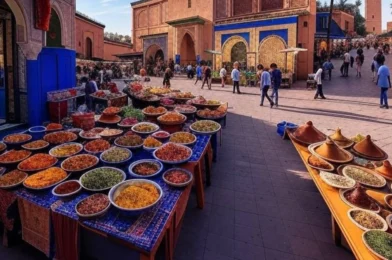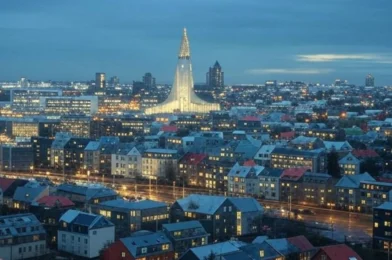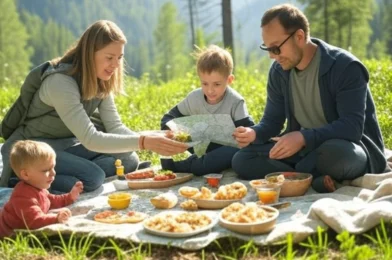Why Marrakech Ignites the Senses
Marrakech, Morocco’s enchanting “Red City,” is a whirlwind of color, sound, and spice. Nestled at the foot of the Atlas Mountains, this ancient hub pulses with life from the labyrinthine souks of the medina to the tranquil courtyards of its riads. Known for its rose-hued walls and vibrant energy, Marrakech blends Berber, Arab, and French influences into a tapestry that captivates every traveler.
This isn’t just a destination; it’s an immersion. The scent of mint tea, the call to prayer echoing through the streets, the kaleidoscope of rugs and lanterns Marrakech is a sensory feast. Whether you’re haggling for treasures, savoring tagine, or unwinding in a hammam, this city offers a journey that’s as exhilarating as it is soulful. Let’s dive into its magic and plan your Moroccan adventure.
Iconic Sights in Marrakech
Marrakech’s landmarks are a mix of history, artistry, and vibrant chaos. Here are the essentials.
Jemaa el-Fnaa: The Beating Heart
Jemaa el-Fnaa, Marrakech’s main square, transforms from a bustling daytime market to a nighttime carnival. By day, snake charmers, henna artists, and juice stalls fill the air with excitement. As dusk falls, food vendors fire up grills, offering kebabs and snail soup, while musicians and storytellers draw crowds. It’s chaotic, mesmerizing, and utterly Marrakech.
Bahia Palace: Opulent Beauty
The Bahia Palace, a 19th-century masterpiece, showcases Moroccan craftsmanship with its tiled courtyards, carved cedar ceilings, and lush gardens. Built for a grand vizier, it’s a maze of rooms that exude luxury and tranquility. Wander its halls to feel the elegance of a bygone era just arrive early to beat the crowds.
Koutoubia Mosque: A Spiritual Landmark
The Koutoubia Mosque, with its 77-meter minaret, is Marrakech’s most iconic silhouette. Non-Muslims can’t enter, but its exterior set against palm trees and a rose garden is a sight to behold. The call to prayer from its tower adds a haunting melody to the city’s soundtrack.
Exploring Marrakech’s Medina and Beyond
The medina is Marrakech’s soul, a UNESCO-listed warren of alleys brimming with life.
The Souks: A Shopper’s Paradise
Marrakech’s souks are a dizzying maze of stalls selling spices, leather goods, lanterns, and textiles. Haggle for a Berber rug or a pair of babouche slippers just bring cash and a sense of humor. The Souk des Teinturiers, where fabrics are dyed in vivid hues, is a visual treat. Get lost, and let the experience unfold.
Majorelle Garden: A Tranquil Escape
Outside the medina, the Majorelle Garden offers a serene contrast. Created by French painter Jacques Majorelle and later restored by Yves Saint-Laurent, its cobalt-blue villa and cactus-filled grounds are a haven. The on-site Berber Museum adds cultural depth, showcasing traditional jewelry and textiles.
A Taste of Marrakech: Moroccan Delights
Moroccan cuisine is a symphony of flavors, and Marrakech is its culinary capital.
Dishes to Savor
Dig into tagine, a slow-cooked stew of meat, vegetables, and dried fruit, served in a conical clay pot. Couscous with lamb or chicken is a Friday tradition, fluffy and fragrant. For street food, try b’stilla, a flaky pastry filled with spiced pigeon or chicken. Finish with pastilla au lait, a creamy dessert layered with almonds and cinnamon.
Mint Tea and Rooftop Vibes
Mint tea, poured from a height into tiny glasses, is Morocco’s signature drink sweet, refreshing, and everywhere. Sip it on a rooftop terrace overlooking the medina, like at Café des Épices, as the sun sets and the city glows. It’s a moment of pure Marrakech bliss.
Practical Tips for Visiting Marrakech
A little know-how ensures your Marrakech trip shines. Here’s the scoop.
Best Time to Visit
Spring (March to May) and autumn (September to November) bring pleasant weather warm days and cool nights. Summer (June to August) is scorching, though quieter, while winter (December to February) offers mild days but chilly evenings. Avoid Ramadan if you want full access to eateries.
Getting Around
The medina is best explored on foot, though narrow streets can disorient download an offline map. Taxis (petit and grand) are plentiful; agree on fares upfront. For day trips to the Atlas Mountains or Essaouira, hire a driver or join a tour. Motorbikes are an option for the brave.
Where to Stay
Stay in a riad traditional homes with inner courtyards in the medina for an authentic vibe. Riad Kniza or Riad Dar Anika offer charm and comfort. Outside the old city, modern hotels in Gueliz provide a quieter base. Book early for peak seasons.
Hidden Gems to Discover
Marrakech has secret spots that reward the adventurous.
Ben Youssef Madrasa: Architectural Serenity
This 14th-century Islamic school stuns with its intricate tilework, stucco arches, and quiet courtyard. Once a hub for scholars, it’s now a peaceful retreat from the medina’s bustle. The detailed craftsmanship makes it a photographer’s dream.
Ouzoud Waterfalls: A Day Trip Delight
A two-hour drive from Marrakech, the Ouzoud Waterfalls plunge 110 meters into a lush valley. Hike down to swim in the pools, spot Barbary macaques, or enjoy a tagine at a cliffside café. It’s a refreshing escape into Morocco’s wild side.
Why Marrakech Leaves a Mark
Marrakech is a city that grabs you its chaos energizes, its beauty soothes, and its flavors linger. It’s a place where every corner tells a story, from the medina’s ancient walls to the mountains on the horizon. Whether you’re lost in the souks, sipping tea at dusk, or gazing at a minaret, Marrakech weaves a spell that’s hard to break.
Ready to step into this Moroccan masterpiece? Marrakech awaits with its red walls and warm spirit start planning your journey today.









